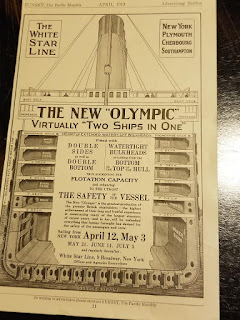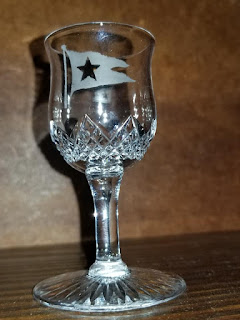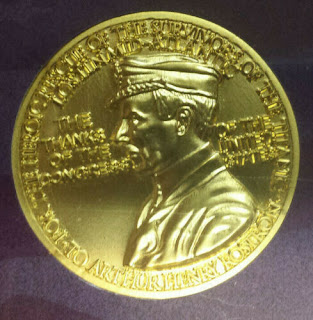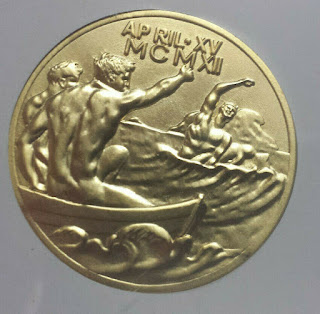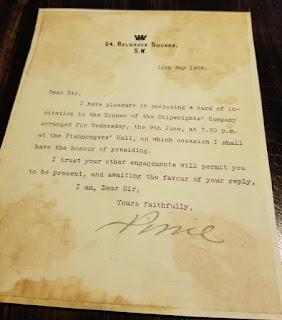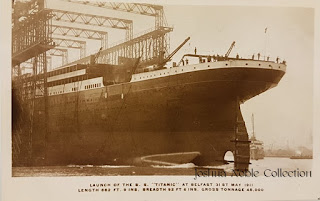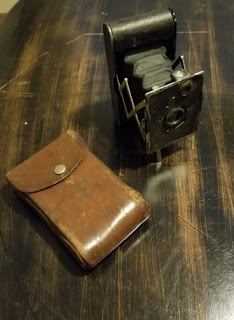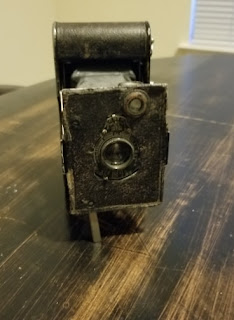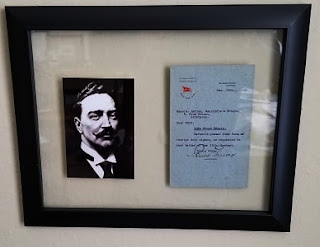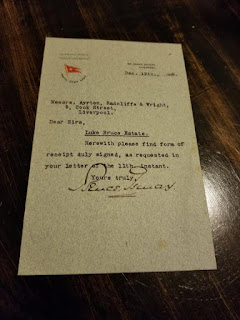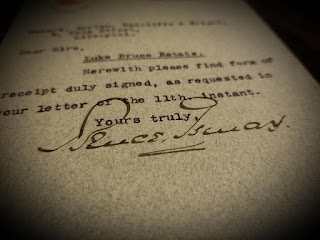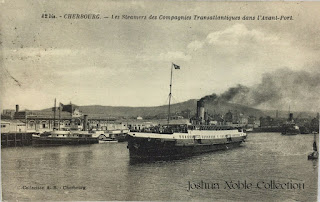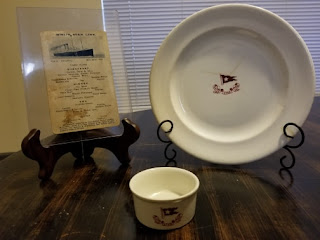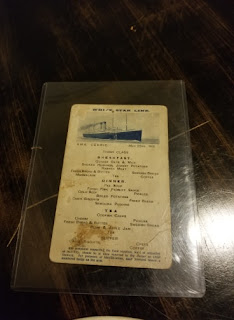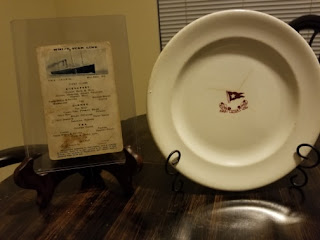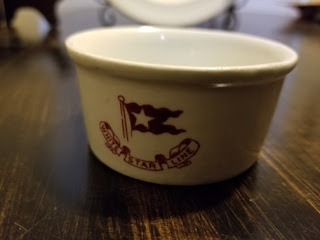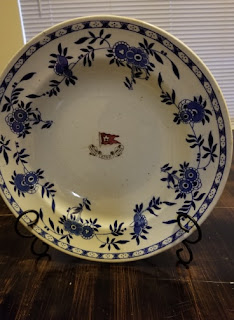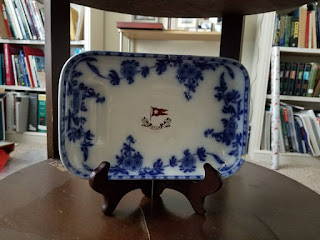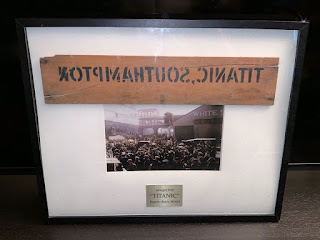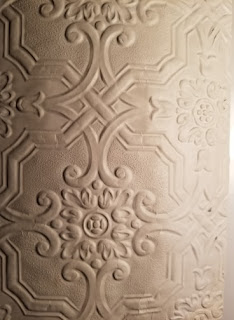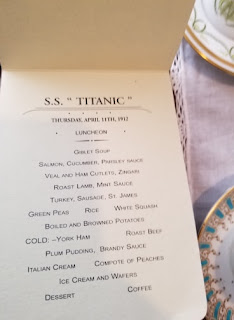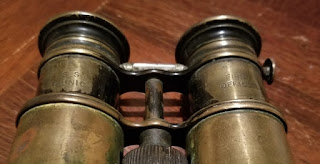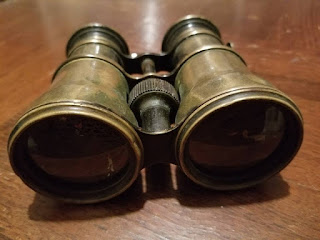After the Titanic sank, changes were made to the designs of upcoming ships to make them safer including more lifeboats. This advertisement from 1913 depicts the changes made to the Titanic's older twin sister ship, Olympic. She was taken out of service and more lifeboats were added along with a thicker hull and higher bulkheads.
Saturday, April 13, 2019
Thursday, March 28, 2019
Captain Rostron Medal
When Captain Rostron rescued the Titanic survivors the morning after the disaster and brought them to New York, he was hailed as a hero. He was given many awards and much praise as a result of his actions. Among the awards he received as a Congressional Gold Medal in 1913. This is a replica of the one awards to him by Congress.
Thomas Andrews
Thomas Andrews (1873-1912) started his career as an apprentice at Harland & Wolff at the age of 16. He came from a family of politicians and businessmen including his great-uncle, Lord Pirrie, who was the Managing Director of Harland & Wolff. He worked his way up and became chief designer. In 1908, Thomas Andrews married Helen "Nellie" Barbour. They had one daughter born in 1910. Thomas Andrews and a group of men who built the Olympic and Titanic called the Guarantee Group sailed on the maiden voyages to make notes of what was going on and how they can improve the next ship. Andrews was on the Titanic for her maiden and final voyage. After the iceberg was struck, Andrews was called on by Captain Smith to investigate the damage. Andrews was the one who calculated the damage and that she would sink. Andrews was seen encouraging people to put on their life jackets and get into the lifeboats and throwing deck chairs overboard for those in the water. He was last seen on the Bridge with Captain Smith. His body was never recovered.
This is a telegram that was sent to Thomas and Nellie from their friend Jim on the day of their wedding wishing them congratulations and telling Nellie he sent keys to them.
Lord Pirrie
Lord William Pirrie was the Managing Director of Harland & Wolff and according to legend was one of the people who had the idea for the Olympic Class. He not only had a great professional shipbuilding career, he also had a political one. He served as Lord Mayor of Belfast and was active in the politics of the time. Harland & Wolff at the time employed a great many people in Belfast. His brother in law was Alexander Carlisle and his great-nephew was Thomas Andrews, both of whom designed the Titanic. In addition, he was a good friend of Captain EJ Smith. When he died in 1924 near Cuba while he was on a business trip to South America, the Titanic's twin sister ship Olympic brought his body back home.
This letter has not one, but two connections. The stationary from 24 Belgrave Square is from Lord Pirrie's home in London where the idea for the Olympic Class Liners was supposedly discussed. The letter from Pirrie invites Mr. Richard May who was a Titanic cross channel passenger to a dinner party. It was in Richard May's scrapbook along with other Olympic and Titanic memorabilia.
Titanic Launch
At 12:15 AM on May 31, 1911, the RMS Titanic's hull moved for the first time. No champagne was broken on the bow as many have done. Instead, rockets were fired to alert ships in the River Lagan and when the signal was given, she moved down the slipway with 22 tons of soap to ease her movement down into the sea.
These pre-sinking photographic postcards show the Titanic just before and during her launch. Both are very rare and hard to find.
Saturday, March 23, 2019
Through The Lenses of History
The things that help us know and envision what it was like to be on the Titanic are primarily photographs and survivor accounts. And the main photographers that documented the Titanic's short life were Robert Welch, Kate Odell, and Father Francis Browne. Below is the same type of camera Father Browne used to take his photographs of the interiors and exteriors during his short time on board. When he disembarked at Queenstown, he brought with him some of the last photographs of the ship and many of her the people on board.
To view his photographs, this website has many of the photographs he took of the Titanic.
J. Bruce Ismay
Joseph Bruce Ismay (1862-1937) as legend has it was one of the people who came up with the concept of the Olympic Class Liners including the Titanic. He was the son of Thomas Henry Ismay, the man who made the White Star Line a major player in many of the shipping lanes and he was the chairman of the White Star Line. J. Bruce Ismay was one of the most famous and criticized people on the Titanic due to the fact it was sailing with enough room in the lifeboats for half on board and the controversial moment in which he survived by getting into one of the last lifeboats to leave the ship. History hasn't always been kind to him, but truth is not always what you see in the movies and a closer look at Ismay's actions in the context of what was going on at the time will show he wasn't really doing anything wrong. He was doing what he could and his actions saved many lives during the lifeboat evacuation.
Being such an integral part of the Titanic story from beginning to end means items from him are highly sought after and often valuable. This letter is a notice of receipt by J. Bruce Ismay from the estate of Luke Bruce who was his maternal grandfather. The letter is on White Star Line stationary from the headquarters in Liverpool and has his original signature after the message.
Being such an integral part of the Titanic story from beginning to end means items from him are highly sought after and often valuable. This letter is a notice of receipt by J. Bruce Ismay from the estate of Luke Bruce who was his maternal grandfather. The letter is on White Star Line stationary from the headquarters in Liverpool and has his original signature after the message.
Monday, March 4, 2019
Titanic Cherbourg
When the RMS Titanic left Southampton starting her maiden voyage on April 10, 1912, her next stop was Cherbourg, France. Because the harbor was too small for the massive size of the Titanic, the White Star Line built two tenders called the SS Nomadic and SS Traffic to ferry passengers and mail from the harbor to the Titanic. They were built around the same time as the Titanic and Olympic in Belfast, Ireland. A total of 281 passengers boarded at Cherbourg.
This postcard features the SS Nomadic which was the largest of the two tenders. The SS Nomadic was built for the 1st and 2nd class passengers and the interiors gave people a mere glimpse of the luxury of the Olympic Class. Even after the Olympic was scrapped and the White Star Line merged with the Cunard Line, the SS Nomadic faithfully transported passengers to the greatest liners to ever cross the Atlantic including the Queen Mary and the Queen Elizabeth. During WWII, she was used to transport soldiers across the English Channel. Many famous people sailed on her including John Jacob Astor IV, the Unsinkable Molly Brown, Charlie Chaplin, Madame Marie Curie, and Elizabeth Taylor. She was retired and turned into a restaurant for years before she was saved from the scrapyard and brought to Belfast, Ireland for restoration. She still exists as a museum in Belfast and is the last surviving White Star Line ship in existence.
This postcard featuring the SS Traffic was a smaller tender meant for transporting 3rd class passengers, luggage, and mail. Not as much is known about her except that during WWII, she was scuttled by the British during the Nazi invasion and the Nazis raised her and scrapped her.
Saturday, March 2, 2019
Titanic China: 3rd class
3rd class on a White Star Liner didn't use any patterns. In 3rd class, they were white with a simple White Star Line burgee logo in the center. Like 2nd class, 3rd class china is very rare and hard to come by. And when you do find some available, they are expensive.
Before I get to the china, I'd like to feature this 3rd class menu from 1913 used on board the RMS Cedric. When you compare what's offered on this menu with what was offered on the Titanic, they offered the same meals and courses with a few exceptions. It's a great glimpse into what they offered back then to eat.
This was a dinner plate used in 3rd class on a White Star Line steamer.
This is one of the rarer pieces in my collection. Regular 3rd class china like plates and such are rare. Specialty dishes are rarer still. This is a 3rd class salt dish used to offer salt to the passengers who wanted to add flavor to their meals.
Titanic China: 2nd Class
While Titanic had multiple patterns in 1st class for her different areas for eating and drinking, 2nd and 3rd class had 1 type of china respectively. In 2nd class on the Titanic, they used the Blue Delft pattern which was fairly common at the time. It was a beautiful flowery pattern with vines that often interlocked around the edge. Surprisingly, while 1st class china is often more fragile, it is the most common partly because it was pocketed the most due to the beautiful patterns and found uses elsewhere even after the White Star Line was merged with Cunard in 1924. However, for 2nd and 3rd class china, it is much rarer and harder to find. 2nd class china hardly comes up for sale and when they do, they are very expensive. But I was able to purchase 2 beautiful examples of original White Star Line 2nd class china which you can see below.
Sunday, January 27, 2019
Titanic (1997)
When most people think about the Titanic, they can't really do it nowadays without thinking of Jack and Rose in the 1997 movie. With it being one of the highest grossing movies of all time, Titanic made a huge iceberg-sized impact in our consciousness and culture when it was released and brought on a new surge of fans and people interested in the subject. While the movie had many flaws (this isn't the place for listing all of them), they got a lot right thanks to the dedication of James Cameron and his team wanting to recreate history as close as possible. Whether you love the movie, or hate everything including the whimsical lyrics of Celine Dione's popular song, there's no denying that the movie has done much to further the memory and legacy of the Titanic.
When they were building the set for the ship, they ended up building one side for budget reasons and placed it so the smoke coming out of the funnels went aft with the wind. But when it came time to film the scene where the Titanic departs from Southampton and Rose comments that "It doesn't look any bigger than the Mauretania," they realized that it was the wrong side historically. In order to correct it, James Cameron decided to film it in reverse and flip the shots in post-production so that history would be honored. In doing so, they reversed all signage to read backwards so it would be correct when they flipped the shot. This board which came from a crate was there on the Southampton docks in the background shots.
One of things I really enjoyed about the movie was the recreation of so many of the luxurious interiors of 1st class. This wallpaper was used either in the 1st class Reception Room or 1st class Dining Saloon sets which were faithfully recreated in all their glory as the passenger glided down the Grand Staircase and tasted the food listening to Jack talk about his life as a "tumbleweed blowing in the wind."
One of the most beloved characters in the movie as well as most beloved people in the Titanic story was Thomas Andrews who was played so well by Victor Garber. Speaking through a Northern Irish accent, Victor Garber brought the legendary designer to life well telling Rose, "I'm sorry I didn't build you a stronger ship." Though he's not the first man to have portrayed Andrews, he's certainly one of the most memorable. This is an autograph photograph which I got when I had the good fortune of meeting him.
While the china, glassware, and cutlery in the movie weren't completely accurate, they did make the effort to make them similar to what was used on board. This is a wine glass from the 1st class Dining Saloon set used as a prop in the movie. Jack Dawson drank out of a similar smaller glass when toasting, "To making it count!"
Even though historically the 1st class passengers never ate in the Verandah Cafe, the 1997 film had their first dinner scene set there immediately after the "King of the World" moment. This menu is from that scene and you can see the "Roast Lamb, Mint Sauce" offered from which Cal said, "We will go for the lamb. Rare with very little mint sauce."
Saturday, January 12, 2019
White Star Line Binoculars
On board the RMS Titanic, there were multiple pairs of binoculars mainly used by officers and lookouts. Contrary to what some may believe, they didn't primarily use binoculars for viewing things around them because binoculars limited their field of vision to specific areas. When binoculars were used, they were mainly used when something was sighted far away and they needed to get a better look at it. Before the Titanic set sail, the binoculars for the lookouts were in a locker and David Blair who was originally was going to be 2nd officer and due to a shuffle left the ship in Southampton accidentally left the ship with the keys to that locker. So for the voyage, they were left with no access to them. Following the Titanic disaster, this was a heavily criticized as being one of the contributing factors of the disaster. Since then, historians have debated on whether or not they really would have made a difference and today, many believe they would not have changed the outcome. In the debris field, a pair of binoculars were found and recovered from the wreck site.
These binoculars were used by the 1st officer of the SS Runic which was a White Star Line steamer that sailed from 1900 until 1940 when she was torpedoed and sunk. On top of the White Star Line connection, the binoculars were made by JW Ray & Co. which was the company that made and supplied the engine telegraphs for the RMS Olympic and RMS Titanic.
Friday, January 11, 2019
Titanic Coal
On board the Titanic, there were 29 boilers equipped with 162 furnaces meant to keep the Titanic running. The stokers and firemen worked below, shoveling coal from the chutes where they were stored in one wall to to the furnaces on the other side. These men rarely saw sunlight during the whole voyage and worked not only a very hot job, but also a very dirty job as they shoveled coal kicking up coal dust. This led to their nickname being "The Black Gang." Despite what some may believe, not all of the Titanic's boilers were lit. They were divided by watertight compartments into six boiler rooms and 5 of them were used, leaving Boiler Room No. 1 unused. The men hired to staff that boiler room were given another task, putting out a coal fire. Coal fires were not uncommon at the time and despite popular belief, it did not cause or contribute to the sinking. To get this fire out, the staff from Boiler Room No. 1 were assigned to Boiler Room No. 5 to clear out the whole chute which they did on April 13th. The stokers were among the first to notice the collision and water as the iceberg caused water to pour into Boiler Room No. 6 and Boiler Room No. 5. The first thing they did was get the fires out. With the very cold water and very hot boilers, they didn't want a boiler explosion. So they released the steam from the furnaces up through the funnels and gradually cooled the boilers. Not very men survived from the boiler room. During the break up, Boiler Room No. 1 and 2 were affected. Boiler Room No. 1 was ripped apart sending the boilers straight to the bottom and the coal in the bunkers with them. It also exposed the boilers in Boiler Room No. 2 at the back of the bow section and are still visible in the wreck today. As it turned out, one of the boilers from Boiler Room No. 1 was the first recognizable item from the Titanic seen confirming to the French-American teams led by Jean-Louis Michel and Dr. Robert Ballard that they had found the wreck of the Titanic.
Coal is the only artifact recovered from the ship's wreck site you can legally own. You can typically find small pieces of coal at artifact exhibition gift shops and people have turned them into different things such as necklaces and bracelets. This is a larger lump of coal than usual and if you look closely, you can see the red rust from the wreck site still clinging to it from contact with something at the wreck site.
Subscribe to:
Posts (Atom)
